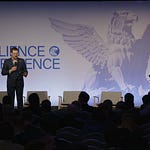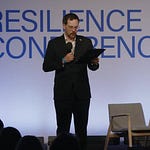Tiberius Aerospace wants to change how we build and field weapons. I spoke with Andy Baynes, chief strategy officer and co-founder. He comes out of Apple and Nest, then time in Ukraine building an AI company. He has seen fast hardware cycles up close. He is now trying to bring that pace to defense.
The first line is concrete. Tiberius’ initial innovation was a liquid fuel ramjet missile that launches from a howitzer. They’ve also built a solid fuel ramjet with guidance and a stated 200 kilometer reach. Both sit inside an open architecture. Thanks to their Generative Real-Time Artificial Intelligence Lethality (GRAIL) technology, parts can be swapped, tested, certified, then pushed into production on tight cycles. If a better piece shows up from a third party, it should slot in without drama. Further, thanks to Baynes’ experience at Apple, he knows how to make software ecosystems that allow the weapons to modified in the field in real time.
Baynes calls this a design and delivery model that keeps the best engineers on program. That is normal in phones and cameras. In defense, it still feels rare. The aim is simple, field a working round today, build the next one at the same time, and repeat. Ukraine’s front shows why. Electronic warfare shifts week to week.
That development is not a free-for-all, said Baynes. Hardware modules face certification by the program owner. Targeting, hookups, and settings can be prepared before storage or adjusted forward of the line. Some parts stay locked for safety. Some parts stay writable. The goal is to allow engineers in the field to control their weapons more precisely and with more clarity.
Behind the missiles sits GRAIL, a design and development platform that aims to federate a wide supplier base, both defense and non-defense. The claim is bold, a one stop shop by next year. The point is not only speed. It is also a new contract shape. Separate design from manufacturing. Let primes keep factories hot. Let fast movers handle the R and D loop. Use open standards so the best part wins on merit and test data, not on bundling.
Why did he help built Tiberius? Baynes was building a startup in Ukraine when the war erupted. Knowing the gravity of the situation, he shipped medical kits into Ukraine and he helped move families west. When former Google colleague pulled him toward a novel ramjet line he decided to go back into hardware but in a way that was arguably alien to his consumer roots. He says the stakes at Tiberius are higher than thermostats or cameras. When war broke out he knew he needed to get back to building.
“I was about ready to get back into hardware at that point… I was more interested in the product and [CEO Chad Steelberg], and the vision that he and I shared to really make a game changing difference for war fighters on behalf of democracy in the West,” he said. Check out the rest of his wide-ranging interview above.










